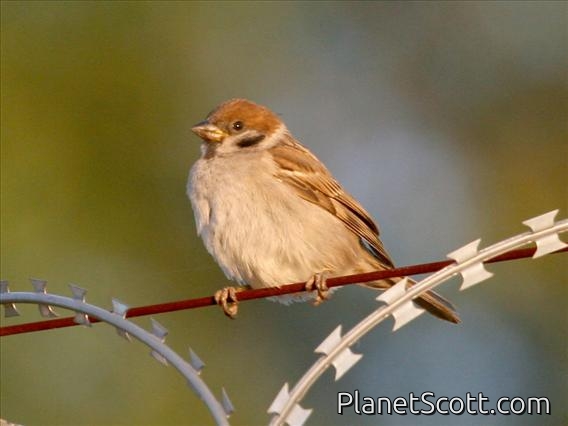Eurasian Tree Sparrow (Passer montanus)

Eurasian Tree Sparrow (Passer montanus)
×


Eurasian Tree Sparrow (Passer montanus)
About Eurasian Tree Sparrow (Passer montanus)
- Kingdom: Animals
- Phylum: Chordates
- Class: Birds
- Order: Perching Birds
- Family: Old World Sparrows
The Eurasian tree sparrow is a passerine bird in the sparrow family with a rich chestnut crown and nape and a black patch on each pure white cheek. The sexes are similarly plumaged, and young birds are a duller version of the adult. This sparrow breeds over most of temperate Eurasia and Southeast Asia, where it is known as the tree sparrow, and it has been introduced elsewhere including the United States, where it is known as the Eurasian tree sparrow or German sparrow to differentiate it from the native American tree sparrow. Although several subspecies are recognised, the appearance of this bird varies little across its extensive range.
Source: Wikipedia
Trips
Visits
-
2006-03-15
Chiemsee, Germany -
2006-03-22
Ilhara Valley, Turkey -
2008-07-19
Irkutsk - Freeway Swamps, Russia -
2008-08-08
Krasnoyarsk - Yenesey South Bank, Russia -
2009-07-13
Victoria Peak, Hong Kong -
2009-07-23
Hangzhou - Xi Hu, China -
2013-01-03
Shanghai, China -
2013-01-05
Tacheng, China -
2013-01-13
Hanoi, Vietnam -
2013-01-18
Hoi An, Vietnam -
2013-01-20
Dalat, Vietnam -
2013-01-23
Ta Nung Village, Vietnam -
2013-01-29
Kratie, Cambodia -
2013-01-30
Phnom Penh, Cambodia -
2013-02-01
Ang Trapeang Thmor, Cambodia -
2013-02-02
Pak Thale, Thailand -
2013-02-04
Hua Hin, Thailand -
2013-02-05
Khao Sam Roi Yat National Park, Thailand -
2013-02-06
Ko Tao, Thailand -
2013-02-11
Bangkok, Thailand -
2013-02-26
Chiemsee, Germany -
-
-
-
-
-
-
-
-
-
-
-
-
-
-
-
-
-
-
-
-
-
-
-
-
-
-
-
-
-
-
-
-
-
-
-
-
-
-
-
-
-
-
-
-
-
-
2024-07-28
Malagufuk, Indonesia -
-
-
-
-
-
-
-
-
-
-
-
-
-
-
2024-08-29
Manupeu Tanah Daru National Park, Indonesia -
-
-
-
-
-
-
-
-
-
-
-
-
-
-
-
-
-



